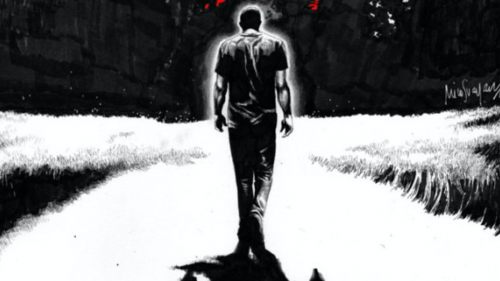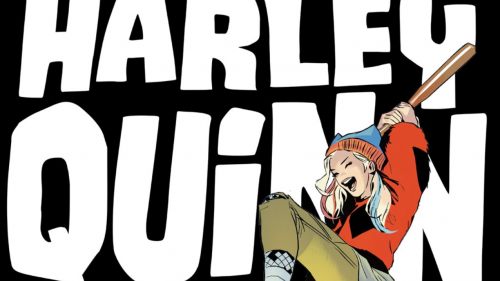Love THE INCREDIBLES? Give NIMONA A Try
FAIR WARNING: Light spoilers for The Incredibles and Nimona to follow.
The Incredibles and Incredibles 2 are fantastic films. Writer/director Brad Bird and the filmmaking team he works alongside have created superhero movies that are simultaneously excellent executions of the form and play with its established language in joyous, brain-tickling ways. Their retro future world is both gorgeous and gloriously distinct. There’s nothing out there that looks quite like Bird’s clean-lined buildings and elegant (cape-free), icon-centric supersuits. The Incredibles’ cast of characters, from its ensemble players to the complex, well-rounded and deeply lovable Parr family, linger past the credits. And that action! Elastigirl (Holly Hunter)’s rescue of a remotely hijacked high-speed train in Incredibles 2 is one of 2018’s finest action sequences. And the Parr family’s first team-up against Syndrome’s murderous enforcers in The Incredibles remains an indelible movie moment, even 14 years on.
The Incredibles pictures are terrific art. And one of great art’s best features is its ability to serve as a guidepost. If you dig The Incredibles and Incredibles 2, there’s a treasure trove of work out there that will sing to you for similar reasons. Work like Noelle Stevenson’s webcomic-turned-graphic-novel Nimona.

At first glance, Nimona and the Incredibles may seem slightly mismatched. One is a dramedy about a gleeful shapeshifting henchwoman and her beleaguered supervillain boss in a kingdom that has both knights jousting in plate armor and flat screen televisions. The other two are superhero adventures about a loving and conflicted family making their way in a world that banished superheroism to the shadows. Look closer. Many of the things that make the Incredibles movies so beloved are amongst Nimona’s many strengths.
Both Nimona and the Incredibles movies are works that play well to all ages, ones which balance levity and pathos with elegance and care. They get heavy, but never out of nowhere. When they get bleak, it's because that’s where their stories need to go. When they’re funny, they’re screamingly funny. They’re sweet without being saccharine. They are, in other words, refreshingly grown-up in the way they tell stories, and thereby ensure that they click with everyone from children to parents to pop culture writers.
Visually, Nimona and the Incredibles pictures are gorgeous works which simultaneously execute their genres with admirable skill and experiment with the look, rules and language of those genres in delightful ways. Their action is clean, clear, creative and above all else, varied. The Incredibles has the confrontation with the Omnidroid. Incredibles 2 pits super-powerful, multi-powered baby Jack-Jack against a tenacious raccoon who really, really wants to pillage the Parr’s garbage. Nimona has everything from the aforementioned horse-mounted joust to a bank robbery almost flawlessly executed via giant laser rifle to a final confrontation amidst a massive conflagration that feels genuinely apocalyptic. All these set pieces play out differently and yet fit together into coherent wholes. On a macro level, the Incredibles movies and Nimona succeed for very similar reasons, and fans of the movies hankering for something made for a similar audience with similar skill would be wise to consider Stevenson’s comic.
And then there’s the micro level, Nimona’s specific virtues. As a writer, Stevenson creates unforgettable characters. And the story she tells makes them interact with each other in a wide range of ways, spurring development and emphasizing their drives, passions, loves, regrets, fears and foibles. Consider the book’s protagonists. Nimona, the title character, is joyously eager to engage in arch villainy, affectionate with her boss Ballister Blackheart and deliberately concealing the true extent of her bloodthirstiness and rage at the world. Working with and befriending Ballister brings Nimona the healthiest relationship she may have ever had in her life (Stevenson deliberately leaves most of her past an enigma), but even then, her trust in him is brittle. Ballister enjoys his life of professional villainy, yet deeply resents the events in his past that led to it. Despite his love of attacking things with genetically modified dragons, Ballister is ultimately a good and altruistic man. Ballister and Nimona develop a deep platonic love for each other, but each misjudges the other’s needs and wants at critical junctures, and they fundamentally misunderstand the nature of each other’s villainy. The potent blend of love, friendship, and miscommunication that Stevenson brews from Nimona and Ballister’s relationship both sets the ground for Nimona’s last act and leads to a brilliantly executed shift in the story’s primary point of view which thrills me every time I read it.
As an artist, Stevenson draws characters who express themselves constantly, whether doing something as simple as standing stiffly (the unnamed, hateful Director of the Institution that rules the kingdom where Nimona takes place in all but name) or as personal and idiosyncratic as celebrating Father Christmas having visited in the night (Ballister’s beloved turned rival Ambrosius Goldenloin [he misspelled Goldenlion when choosing his name]). Her skill with tonal balance means that while Nimona’s transformations are always visually striking, they can range from the unexpected and comic (her inaugural shark transformation) to the visceral and horrifying (her combat transformations, particularly once the immense scale of her powers become clear). On a related note, as wild as Nimona’s world is, Stevenson’s makes everything feel like it belongs together, from the chainmail of the Institution’s guards to Ballister’s metal arm to a hospital chart with an unexpected drawing. In other words, thanks to Stevenson’s control of her story’s tone, look and feel, there’s room in Nimona for both of the following pages:


It’s masterful work, and its praises should be sung as widely and fervently as those sung for The Incredibles pictures, its cousins in storytelling targets and quality.



